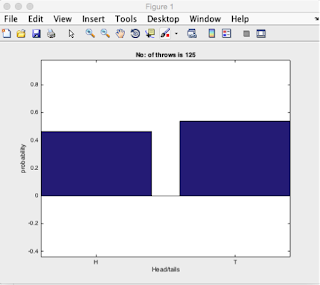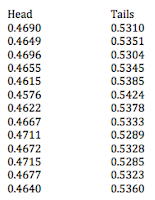A Tossing Coin Simulation Using Matlab
Ok,
my lecturer has given the whole class a challenging task a week ago. It’s not
something we’re not capable of, because of course we’re engineering student,
what’s impossible? (As long as Google is in a healthy condition). It’s all
about probability of getting a result from tossing a coin for BILLION TIMES.
You wanna do it in an old style way? Go on. No one will ever stop you, but
yourself, your hand, and also the arm are gotta have some hard times soon,
flipping it for eternity.
So
I’m starting a research over Google for tossing a coin and deciding what kind
of application/software/codes I need to do with this coin simulation.
The
results are coming out like these:
www.random.org/coins
justflipacoin.com
www.shodor.org
www.virtualcointoss.com
Trust
me these are helpful enough, but I’m just not that satisfied.
.....because I need something new, lol, no I mean, I’ve been flipped upside down by Matlab
few days ago, and kinda get excited to involve this coin thingy with Matlab.
So I
found some helpful results, but accidentally fell in love with few of them only
((FYI, I’m including the source at the bottom of my article, no need to
worry!)).
The
first program goes to… *drumrolls*
Tossing Coin Simulation Using Matlab (For Trials Under 50000 Times With Graph)
Tossing Coin Simulation Using Matlab (For Trials Under 50000 Times With Graph)
Tbh,
you can give any kind of amount you need, but this is not accurate tho’, it
lacks in still many way if you’re inserting a really big amounts (it takes time
for creating the graph), you will wait for forever, your pc will just stop from
beating. But here’s the code, I insert 125 for the flipping numbers.
%for counting the probabilities
clc
y=[1 2]; %assigning value to y
a=0; %assigning
value to a
b=0; %assigning
value to b
k=125; %number of trials
for i=1:k, %start
number for loop
ran=randi([0,1]); %random head and tails generating 0 for head 1 for tails
if ran==0 %if head
happens
a=a+1; %a should
increase by 1
elseif
ran==1 %else if tails happens
b=b+1; %b should
increase by 1
end %end
of if
m=a/i; %probability
of total head/total outcomes
n=b/i; %probability
of total tails/total outcomes
x=[m n] %putting
probabities of head and tail in array
%for creating the graph
bar(y,x) %Plotting bar graph y in x axis and x in y axis
bar(y,x) %Plotting bar graph y in x axis and x in y axis
xlabel('Head/tails') %x axis label
ylabel('probability')%y axis label
title(['No: of
throws is ',num2str(i)]) %title with
changing trials
set(gca, 'XTick',1:2, 'XTickLabel',{'H' 'T'}) %x
axis change to H and T
axis equal %making axis
equal for animation
M(i) = getframe; %getting
frame at each for loop run
end %end of for loop
Here’s
the column chart result of 125 times in flipping the coin:

It’s
going to be such waste to mention all the 125 probabilities here, so I give the
last 13 results, there we go:

The first-author said, it’s better to get
the results when the K value is getting bigger which means you need to flip the
coin for more than 50 times. It's a true after all! Because when the K value is gettin' higher, the probabilities number you'll have is getting more accurate, so it will likely to appear in the same number which it can prove the theory of probability for 2 coins, about 0,5.
But
I assume that when you try for a higher number, I suggest not to create the graph based on the 'changing trials'. What is the reason? Ok lemme tell you tha your Matlab will run for forever because the process is going to do so unless it reached the number you input. So you just need to delete the graph part, or making the graph based on the final probability score between the head and tail part.
It's really worth a try, happy programming!
Subscribe to:
Post Comments
(
Atom
)

No comments :
Post a Comment